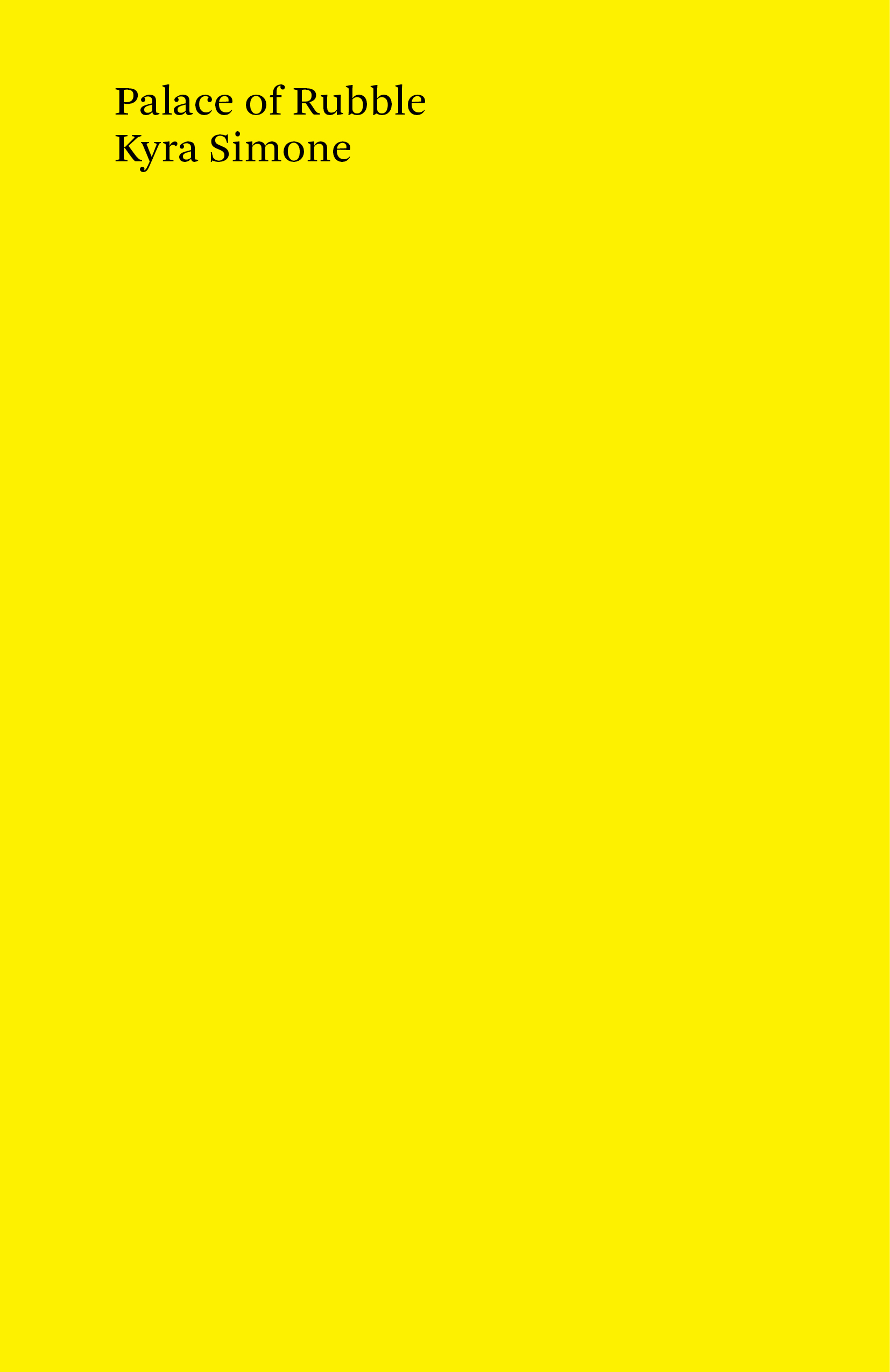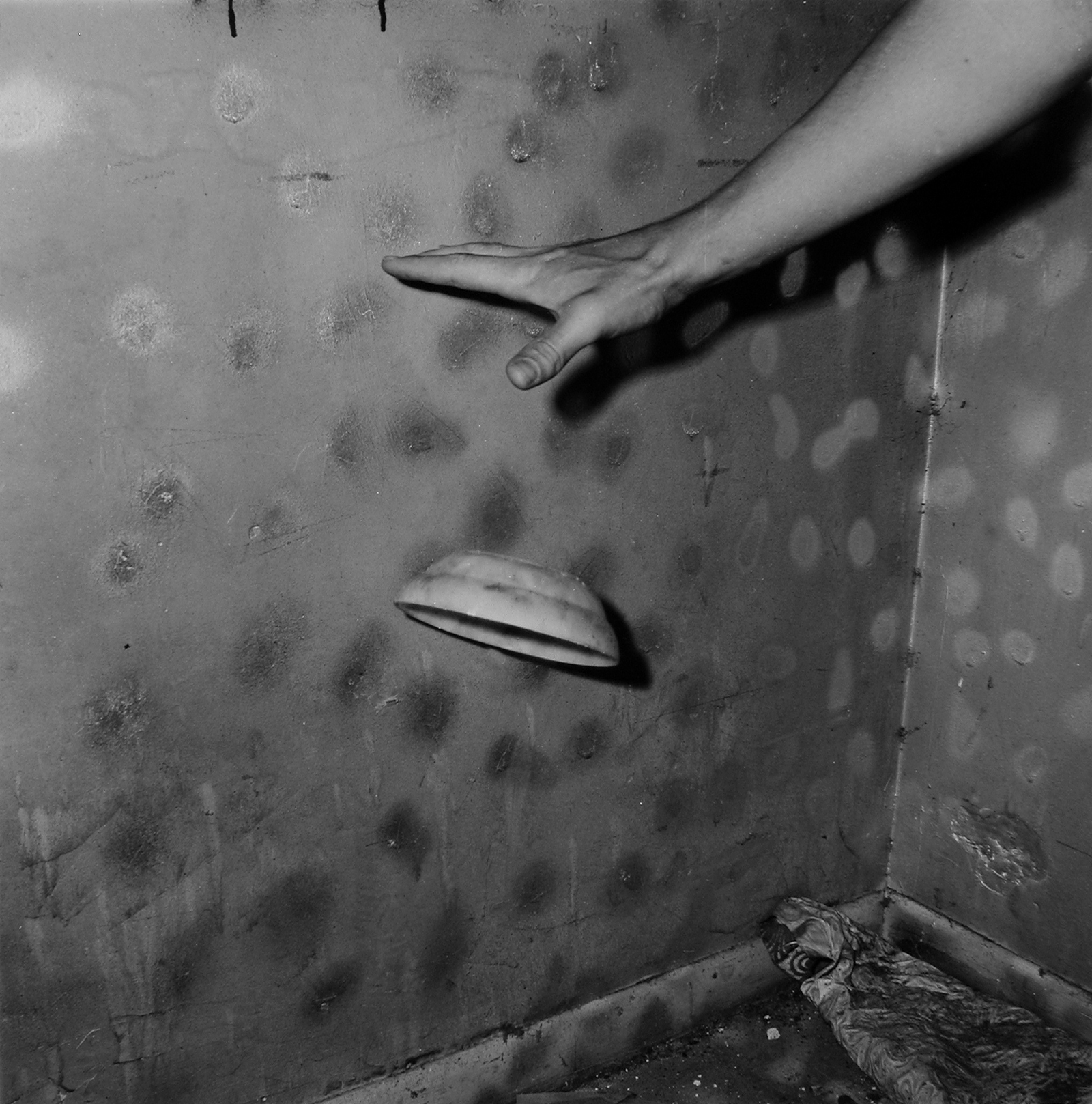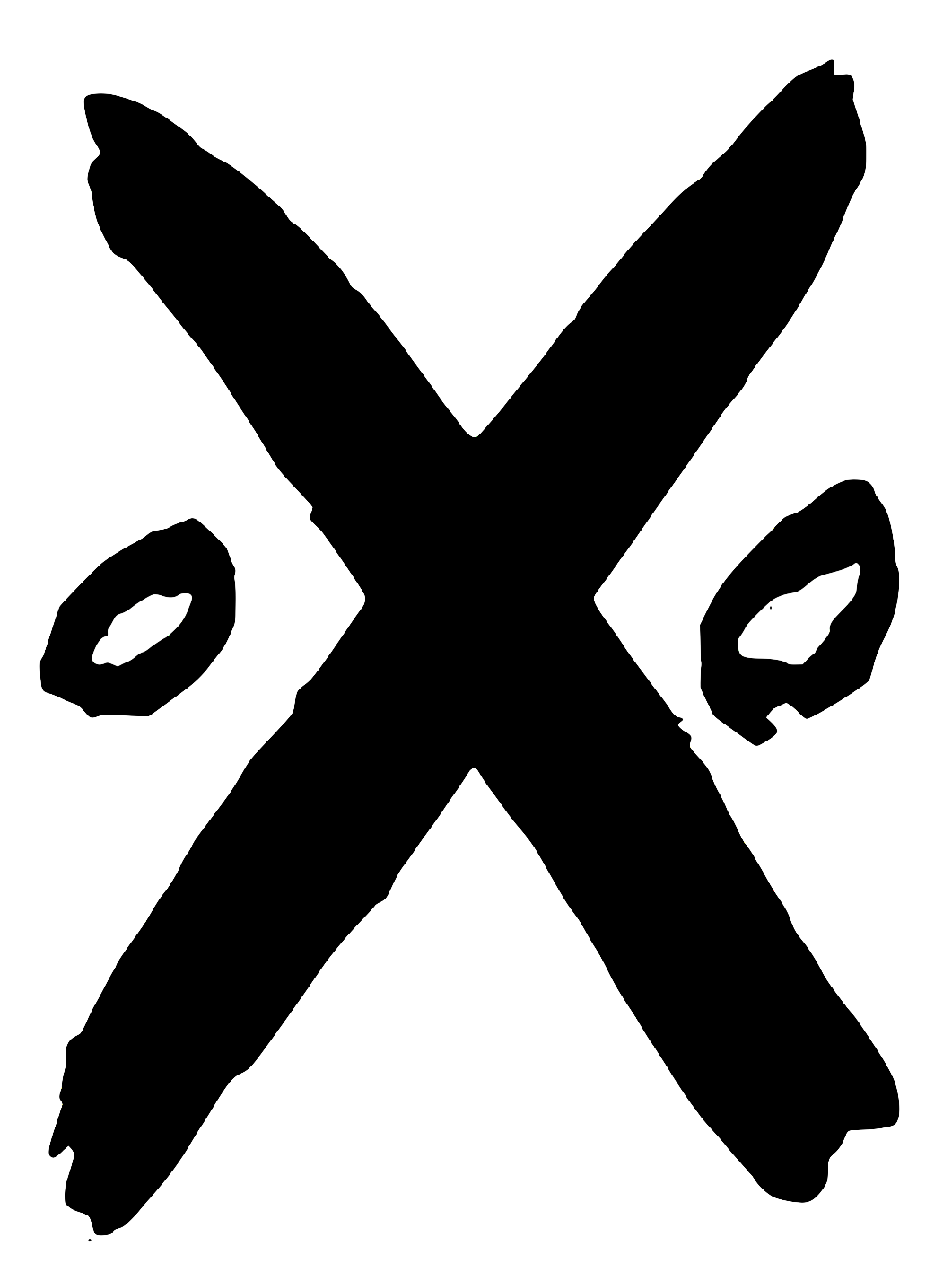

John Divola, ‘Zuma #8’ (1977)
Palace of Rubble
Kyra Simone
With photography
by John Divola
Tenement Press #6
978-1-8380200-7-1
170pp
£16.50
ORDER DIRECT FROM TENEMENT HERE
Published 4th October 2022
Majestic flights of fancy spun around ravaged landscapes and savage realities, these are remarkable prose poems for the 21st century.
Chloe Aridjis
Reading Kyra Simone’s work is reminiscent of an archaeological excavation. We dig down, down, down until we have emerged on the other side of the earth, viewing a world turned upside down, both alien and familiar. We have just enough time to contemplate the madness and achievement of our endeavour before we are giddy with the blood rushing to our heads. The writing has dug to the past and emerged in the future, passing on its way those civilisations, kingdoms and palaces long since blown away or buried, it is covered in their dust. And I think about that palace—the human body and spirit—emerging from the rubble, broken, neglected, dusty, ripe for rebirth, glowing in the light of the fragile splendour of Divola’s images that seem to be exposed ‘to a patch of sky’ as Simone writes. And the palace then contains the sky. I can’t help but think, isn’t this madness? Isn’t life beautiful.
Vanessa Onwuemezi
Kyra Simone
With photography
by John Divola
Tenement Press #6
978-1-8380200-7-1
170pp
£16.50
ORDER DIRECT FROM TENEMENT HERE
Published 4th October 2022
Majestic flights of fancy spun around ravaged landscapes and savage realities, these are remarkable prose poems for the 21st century.
Chloe Aridjis
Reading Kyra Simone’s work is reminiscent of an archaeological excavation. We dig down, down, down until we have emerged on the other side of the earth, viewing a world turned upside down, both alien and familiar. We have just enough time to contemplate the madness and achievement of our endeavour before we are giddy with the blood rushing to our heads. The writing has dug to the past and emerged in the future, passing on its way those civilisations, kingdoms and palaces long since blown away or buried, it is covered in their dust. And I think about that palace—the human body and spirit—emerging from the rubble, broken, neglected, dusty, ripe for rebirth, glowing in the light of the fragile splendour of Divola’s images that seem to be exposed ‘to a patch of sky’ as Simone writes. And the palace then contains the sky. I can’t help but think, isn’t this madness? Isn’t life beautiful.
Vanessa Onwuemezi
Kyra Simone’s Palace of Rubble is a collection of stories composed primarily of single words culled each day from the New York Times, among other news sources. Written under constraint in the tradition of Oulipo, these hybrid works of prose are reconstructions that no longer resemble the original texts, yet draw from the same reservoir of vocabulary, conveying new images and ideas, while preserving some distant ember of the universe from which they were first generated.
Kyra Simone reads ‘The Prairie is on Fire’
Initially inspired by a photograph of one of Saddam Hussein’s demolished palaces printed on the cover of a newspaper Simone found discarded on a café table during the fall of Baghdad in 2003, Palace of Rubble has since evolved into an accumulation of texts invoked by a historical moment spanning the eras of Bush, Obama, Trump, and into the present day. Offering surreal glimpses of what might be identified as echoes of a post-Republic America, an imagined Middle East, and some other unnamed and unreachable world, it chronicles a vivid landscape of crumbling towers and heart-broken animals, eclipses, comets, and lovers in abandoned rooms, still searching for beauty amidst the ruins of the catastrophe bequeathed to them.
Accompanying these hybrid texts are images of vacant buildings along the California coast, as drawn from John Divola’s photo series ‘Vandalism.’
For the attention of ‘brick & mortar’ bookshops,
order copies of Simone’s Palace via our distributor,
Asterism Books.
order copies of Simone’s Palace via our distributor,
Asterism Books.
Temporary Palaces / Resonance Extra
An unabridged reading of the stories collated in Simone’s Palace of Rubble, as read by Simone, and recorded for broadcast on Resonance Extra for Tenement’s rolling and roving sonic series, Railroad Flat Radio.
Temporary Palaces was produced by Dominic J. Jaeckle and Milo Thesiger-Meacham, and recorded on location in Resonance’s Bermondsey chapel studios, London, accross two days in late, October, 2022. The collection was broadcast in three instalments as ‘Tarzan the Apeman’ (22.04.23), ‘The Wild One’ (27.05.23), and ‘The Stranger’ (01.07.23).
Kyra Simone is a Tunisian-American writer from Los Angeles, now based in Brooklyn. Her fiction and poetry have appeared in a variety of literary journals, including Conjunctions, The Brooklyn Rail, BOMB, Entropy, The Anthology of Best American Experimental Writing, and elsewhere. Simone is a member of the publishing collective Ugly Duckling Presse, and part of a two-woman team running the editorial office of Zone Books.
John Divola works primarily with photography and digital imaging. While he has approached a broad range of subjects he is currently moving through the landscape looking for the oscillating edge between the abstract and the specific. Since 1975, Divola has taught photography and art at numerous institutions including California Institute of the Arts (1978-1988), and (since 1988) he has been a Professor of Art at the University of California, Riverside. Divola's work has been featured in more than seventy solo exhibitions in the United States, Japan, Europe, Mexico, and Australia, and in more than two hundred group exhibitions in the United States, Europe, and Japan.
Like traditional methods of salting, pickling, drying, and smoking, Palace of Rubble saves transitory substance from expiration. From the stuff we unfold in the morning and throw in the recycling bin at night, Simone coaxes the rhythms of cyclical life, the patterns and variations on patterns that define the sphere of the daily, that baseline on which extraordinary events and crises exert their pressure. The world she constructs is recognizable, textured, gently humorous—but also luminously, piercingly exact, possessed of the strangeness of seeing something for the first or the last time—a lamp store in Chinatown is “a gallery of lights all blinking in dissonant rays of color,” the disassembling of a famous church that will be put together a few miles up the road is rendered via “the villagers holding pieces of it in their hands as they head over the hill in a great procession into the distance.” As the author herself puts it, these texts retain “a distant ember of the world from which they were first generated,” an effect that can feel for the reader like peering into a place that is both familiar and unknown, gazing at this place through the blur and distance implied by the passage of large swathes of time, physical displacement or shifts in ontological perspective.
Alexandra Kleeman
Kyra Simone reading at McNally Jackson (New York),
28th September 2022.
Epics are generally in sections or cantos, but there’s also a narrative coherency that supersedes the modular nature of the individual poems. Palace of Rubble is that way, too; there's no single dominant narrative that asserts itself across every story, but there are narrative currents and recurring characters and preoccupations. The sections flow into each other in a way that also feels reminiscent of a certain kind of deconstructed epic. If the linebreak is a technology that creates “units” or slows the pace of the reader’s eye on the page, I would argue that part of the power of the prose in Palace of Rubble has to do with the lack of separation, the lack of breath or space between ideas, and how that density operates on our attention. Each chunk of prose becomes its own edifice.
Maggie Millner,
BOMB
![]()
John Divola, from the ‘Vandalism’ series (1975/1977)
I was hooked by the very first sentence of Kyra Simone’s Palace of Rubble... “A breaking wave collapses on the bank before two half-naked women on white Arabian horses.” The sentence is so precise, down to the use of the erotic “collapses.” Plunged into this direct, clear, and mysterious arrangement of words, I was always left wondering what will happen next. Where will the next sentence take me? I was never disappointed. Simone is able to maintain and shift that propulsive curiosity throughout the book. While dancing with us, each sentence is a journey. Each story is a multi-faceted gem—a “beguiling dream of eternal cinema.”
John Yau
Kyra Simone’s prose is a blowtorch of liberation.
Filip Marinovich
Alexandra Kleeman
Kyra Simone reading at McNally Jackson (New York),
28th September 2022.
Epics are generally in sections or cantos, but there’s also a narrative coherency that supersedes the modular nature of the individual poems. Palace of Rubble is that way, too; there's no single dominant narrative that asserts itself across every story, but there are narrative currents and recurring characters and preoccupations. The sections flow into each other in a way that also feels reminiscent of a certain kind of deconstructed epic. If the linebreak is a technology that creates “units” or slows the pace of the reader’s eye on the page, I would argue that part of the power of the prose in Palace of Rubble has to do with the lack of separation, the lack of breath or space between ideas, and how that density operates on our attention. Each chunk of prose becomes its own edifice.
Maggie Millner,
BOMB

John Divola, from the ‘Vandalism’ series (1975/1977)
I was hooked by the very first sentence of Kyra Simone’s Palace of Rubble... “A breaking wave collapses on the bank before two half-naked women on white Arabian horses.” The sentence is so precise, down to the use of the erotic “collapses.” Plunged into this direct, clear, and mysterious arrangement of words, I was always left wondering what will happen next. Where will the next sentence take me? I was never disappointed. Simone is able to maintain and shift that propulsive curiosity throughout the book. While dancing with us, each sentence is a journey. Each story is a multi-faceted gem—a “beguiling dream of eternal cinema.”
John Yau
Kyra Simone’s prose is a blowtorch of liberation.
Filip Marinovich


